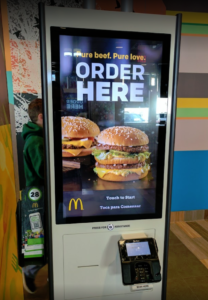 Earlier this month I attended the Consumer Electronics Show in Las Vegas leading up to CES Government, which I believe is the best event of the year bringing government and industry executives together for collaboration. I plan to write another post focused on cool tech I saw at CES, but here I want to focus on CESG.
Earlier this month I attended the Consumer Electronics Show in Las Vegas leading up to CES Government, which I believe is the best event of the year bringing government and industry executives together for collaboration. I plan to write another post focused on cool tech I saw at CES, but here I want to focus on CESG.
One of the big topics at CESG this year had to do with the impact of artificial intelligence (AI), automation, and robotics on the workforce. By some estimates, more than 80% of all jobs paying $20 per hour or less could be replaced by technology within 30-40 years. There are plenty of visible examples suggesting that timeline may be way too long. Autonomous vehicles are already on the road. The new McDonalds store in my small town replaced two point of sale terminals (and presumably the cashiers behind them) with a bank of four large touchscreen ordering stations. So it seems like this is a legitimate topic for debate.
One of the several facets to the debate is the extent to which technology will augment human labor rather than replace it. In other words, ideally technology will allow the human to skip mundane tasks and focus on higher level ones. That works as long as a) the human has the capacity/ability for performing the higher level tasks; and b) the technology hasn’t advanced far enough to replace the higher level labor too. Speakers at CESG, including Steve O’Keefe from Meritalk and Chad Steelberg from Veritone, argued that Artificially Narrow Intelligence (ANI) – the ability for machines to perform a well-defined task better than any human – is already here today. You can laugh about the mistakes made when dozens of Amazon Echoes hear a tv commercial and place orders for dollhouses, but think instead about how incredibly efficiently they did so compared to a human acting without the use of computers. Chad offered some specific details on the current state of ANI:
He defined General AI as self-generating and self-refining collections of ANI. This is emerging now and only 7-10 years away from being the norm. So this is happening; there’s no denying it.
Another facet is to assume technology will eliminate the jobs – what then? Should government have a role in ‘fixing’ that problem? In CESG’s Jan. 7 round table on the topic, a split emerged along political/philosophical lines with about half the people advocating for government programs to retrain people, find them new jobs, etc. and the other half warning against too much government intervention presuming to know what’s best for each individual. I related my experience growing up in western Pennsylvania and what I’ve seen happen there over the years going back to visit. If robots replace humans, it won’t be the first time many of those people have had to face the problem of their employers shifting to a cheaper form of labor. It happened at many (most?) of the manufacturing plants throughout much of the country.
Werner ladders, for example, used to be manufactured in Greenville, PA; however, they shut down that plant in the 1990s telling the workers, as I recall, that it cost $33/hr to build ladders there but only $8/hr to build them in Mexico and only $2-3/hr to build them in China, even factoring in shipping costs. Home Depot and Lowe’s would not place big orders for ladders costing what Werner had to charge to cover US labor costs. But those workers remade themselves without extraordinary government help. Tragically, many of them – guys I went to high school with – went out and got their CDLs and now drive trucks for a living. I say tragic because one of the most obvious applications of autonomous driving, and a sector that is expected to be an early adopter, is commercial trucking. So these workers are going to have to reinvent themselves again, or hope that the transition takes long enough for them to retire.
Update: I came across this 2015 study from Ball State University which asserts, based on the evidence it presents, that automation/technology already effectively eliminated (or obviated) as many as 9 million manufacturing jobs in the United States from 2000 to 2010.
On the other hand, some big thinkers in the IT world remain hopeful that automation is actually going to lead to more jobs for humans. That’s what the CEOs of Salesforce and IBM have been saying in Davos this week. That might just be happy talk to calm global jitters, or maybe they’re right.
If I were thinking about this just for myself, I probably wouldn’t be too concerned. I’m at least halfway through my working years (I hope) so I’m optimistic that even if the robots take over, I can find a way to work with or around them. But I have four kids, ranging in age from a college freshman to a sixth grader; what about them? What about their kids? I think it’s clear enough now that many kinds of jobs are low-hanging fruit for automation – for example, the literal picking of low-hanging fruit – but others, not so much. As a recent article by Dave and Helen Edwards on Quartz suggests, jobs that deal in the unpredictable may be the safest. They note, “…our research points to an important and valuable insight: the highest human value is not about being plugged in but being unplugged. And in order to excel at these tasks, we need to remove the digital filter and experience the people and physical world around us.”
One thing is for sure: after learning more at CESG about the reality of the automation age, I’m more apprehensive for the next season of Westworld.


